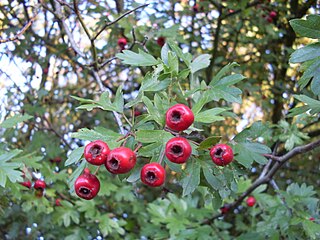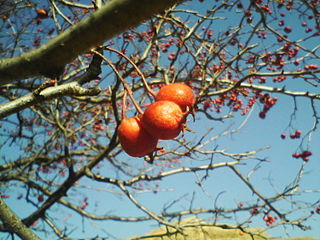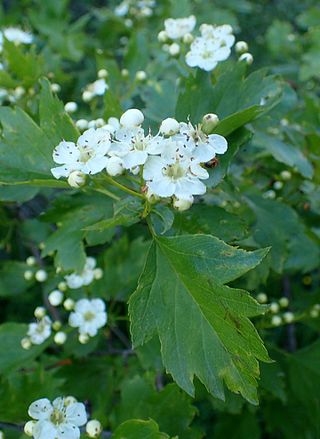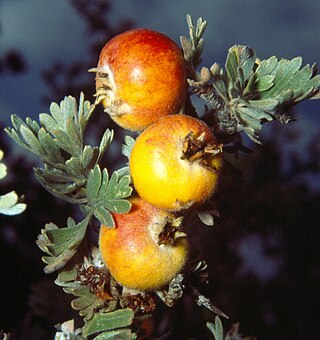
Crataegus, commonly called hawthorn, quickthorn, thornapple, May-tree, whitethorn, Mayflower or hawberry, is a genus of several hundred species of shrubs and trees in the family Rosaceae, native to temperate regions of the Northern Hemisphere in Europe, Asia, North Africa and North America. The name "hawthorn" was originally applied to the species native to northern Europe, especially the common hawthorn C. monogyna, and the unmodified name is often so used in Britain and Ireland. The name is now also applied to the entire genus and to the related Asian genus Rhaphiolepis.

Crataegus monogyna, known as common hawthorn, one-seed hawthorn, or single-seeded hawthorn, is a species of flowering plant in the rose family Rosaceae. It is native to Europe, northwestern Africa, and Western Asia, but has been introduced in many other parts of the world.

Crataegus laevigata, known as the Midland hawthorn, English hawthorn, woodland hawthorn, or mayflower, is a species of hawthorn native to western and central Europe, from Great Britain and Spain east to the Czech Republic and Hungary. It is also present in North Africa. The species name is sometimes spelt C. levigata, but the original orthography is C. lævigata.

Crataegus pinnatifida, also known as mountain hawthorn, Chinese haw, Chinese hawthorn or Chinese hawberry, refers to a small to medium-sized tree, as well as the fruit of the tree. The fruit is bright red, 1.5 in (38 mm) in diameter.

Crataegus douglasii is a North American species of hawthorn known by the common names black hawthorn and Douglas' thornapple. It is most abundant in the Pacific Northwest.

Crataegus azarolus is a species of hawthorn known by the common names azarole, azerole and Mediterranean medlar. It is native to the Mediterranean Basin and is a common plant there, growing on sites comparable to those the European common hawthorn grows on. In the Arab countries it is the most common hawthorn species. When growing in the wild, the azerole bears plentiful crops of haw fruits, which are similar to the haws of the European common hawthorn, but more plump.

Crataegus crus-galli is a species of hawthorn known by the common names cockspur hawthorn and cockspur thorn. It is native to eastern North America from Ontario to Texas to Florida, and it is widely used in horticulture. It is thought to be the parent, along with Crataegus succulenta, of the tetraploid species Crataegus persimilis.
Crataegus × dsungarica is a hawthorn that is a hybrid between C. songarica in C. sect. Crataegus and C. wattiana in C. sect. Sanguineae. It has been placed in nothosection Crataeguineae. It has blackish purple fruit.

Crataegus nigra, the Hungarian thorn, Hungarian hawthorn or black hawthorn, is a black-fruited species of hawthorn native to the western balkan and the Pannonian Basin, spanning from Slovakia to Albania. The fruit, which is up to 10 mm across, can be consumed fresh or cooked.

Crataegus orientalis, known as oriental hawthorn, is a species of hawthorn native to the Mediterranean region, Turkey, Caucasia, Crimea, and western Iran, with fruits that are orange or various shades of red.

Crataegus pentagyna, also called small-flowered black hawthorn, is a species of hawthorn native to southeastern Europe. Two subspecies are recognized, C. p. subsp. pentagyna and C. p. subsp. pseudomelanocarpa. The fruit are usually black, but are sometimes a handsome purple.

Crataegus punctata is a species of hawthorn known by the common names dotted hawthorn or white haw that is native to most of the eastern United States and eastern Canada. While some sources claim it is the state flower of Missouri, the actual legislation does not identify an exact species. Furthermore, the Missouri Department of Conservation asserts the Crataegus mollis was specifically designated as the state flower.

Crataegus rhipidophylla is a species of hawthorn which occurs naturally from southern Scandinavia and the Baltic region to France, the Balkan Peninsula, Turkey, Caucasia, and Ukraine. It is poorly known as a landscape and garden plant, but seems to have potential for those uses.

Crataegus mexicana is a species of hawthorn known by the common names tejocote, manzanita, tejocotera and Mexican hawthorn. It is native to the mountains of Mexico and parts of Guatemala, and has been introduced in the Andes. The fruit of this species is one of the most useful among hawthorns.

Crataegus pulcherrima is a species of Hawthorn native to the southeastern United States. This species and those related to it that are classified in Crataegus series Pulcherrimae have been largely ignored since they were originally described in 1903, but warrant consideration as ornamental cultivated plants.
Stigmella oxyacanthella is a moth of the family Nepticulidae, found in Europe and North America. The larvae are leaf miners feeding inside the leaves of trees and shrubs, such as hawthorn, apple and pear.

Crataegus songarica is an Asian species of hawthorn with black fruit that is sometimes used medicinally. It is closely related to Crataegus ambigua, a species that has red fruit.

Crataegus pycnoloba is a species of hawthorn in the Rosaceae family. It is native to the mountains of the northern and central Peloponnesus of Greece. The plant is a shrub or rarely a small tree. The fruit are red or dark reddish brown when immature, but later develop a yellow background colour.
Crataegus × yosgatica or Crataegus yosgatica is a putative hybrid species of hawthorn. It was thought to be a cross between Crataegus monogyna and C. tanacetifolia. A 2014 molecular and morphological study reduced it to a synonym of Crataegus meyeri.

















